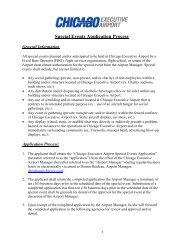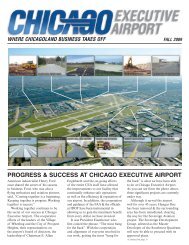Here - Chicago Executive Airport
Here - Chicago Executive Airport
Here - Chicago Executive Airport
You also want an ePaper? Increase the reach of your titles
YUMPU automatically turns print PDFs into web optimized ePapers that Google loves.
<strong>Chicago</strong> <strong>Executive</strong> <strong>Airport</strong> Economic Impact Study–2007 Page 3-3<br />
earning an annual salary of $60,900. However, average payrolls range significantly between<br />
business type and firm. Government employees, which includes many traffic controllers as well<br />
as other airport operation services, generate the highest average payroll of $95,200, Corporate<br />
operations, which employee pilots, mechanics and other support services ($88,800). The<br />
airport service-related firms average $41,900.<br />
Capital Expenses –The $19.3 million in “capital impacts” (see Exhibit 3.2) comprise capital<br />
investments made in which the recipient of the expenditures typically is located in the region.<br />
Capital investment represents physical improvements to airport facilities, either public or private.<br />
However, capital expenditures on aircraft are excluded because the recipient, the aircraft<br />
manufacturer, is located outside of the study region. Funds may come from private sources such<br />
as leaseholders, government agencies such as the airport operator, or through aid grants from the<br />
Federal Aviation Administration (FAA), or the State of Illinois.<br />
The largest share of capital impacts typically originate from the airport operator who manages the<br />
airport, and finances airside and landside improvements. Total airport operator capital costs<br />
evaluated in this study comprise an annual average of the capital costs over the past ten years<br />
and those programmed over the next five years, inclusive of the matching state and federal<br />
contributions. The annual average estimation approach better reflects the typical annual impact<br />
that large capital investment projects have on the local community. For example, actual airside<br />
and landslide improvements averaged $8.5 million over the last 10 years (1998-2007), the vast<br />
majority attributable to the $46.5 million allocated in 2007. This spike in capital expenditures is<br />
expected to continue with an annual average of $24.1 million in programmed expenditures<br />
between 2008 to 2012.<br />
Operation Expenses – Operation expenses include expenditures for local utilities, operations,<br />
parts and supplies, services, aviation fuel, and other local purchases. All of these are of economic<br />
value to the <strong>Chicago</strong> <strong>Executive</strong> <strong>Airport</strong> service area – totaling an estimated $75.4 million. It is<br />
recognized that a significant portion of the airport operation expenses is made by one airport<br />
business to another at-airport business.<br />
3.2 Indirect Impacts<br />
The estimated $17.7 million in total indirect impacts at <strong>Chicago</strong> <strong>Executive</strong> <strong>Airport</strong> include visitor<br />
impacts associated with air taxi, corporate and personal aircraft operations. Each visitor type<br />
demonstrates different travel patterns regarding percent visitors, percent staying overnight and<br />
expenditures per day, etc. Based on these differences, a composite of the visitor impact<br />
estimation is diagramed in Exhibit 3-3.<br />
Wilbur Smith Associates November 2007




